Where and when is it better to drill a well on a site: general rules + advice from experienced drillers
Your house does not have a central water supply, which is why you are thinking about drilling a water well? But due to the lack of experience in this area, you don’t know where to install a water intake on the site, and when is the best time to drill? Agree that all these questions are very important: the performance characteristics of the future water source depend on the answer to them.
We will help you find the right answers. After all, determining the optimal location on your own is not so difficult if you have the necessary knowledge and take into account the features of the site. Our article provides general rules and regulations that should be followed when choosing a location for a well. A variety of ways to search for groundwater are also considered.
To help you choose the best time to drill, we provide tips and advice from industry experts, complete with photos and videos to visualize the entire process.
The content of the article:
- Requirements for the location of the well
- Sanitary standards and regulations
- Selecting a point for drilling a water source
- Visual methods for searching for groundwater
- Empirical ways to find groundwater
- Reliable prospecting method by exploratory drilling
- Unsuitable places for a well
- Well in the basement of a house
- Optimal time for drilling
- Conclusions and useful video on the topic
Requirements for the location of the well
When choosing a place for drilling, many factors are taken into account: the geological features of the site, its topography, the influence of hydrological factors, the location of other economic activities.
In addition, the convenience of the location of the future is important source of water supply, which will allow you to operate it without problems in the future.
The selected location for the well must meet the following requirements:
- presence of an aquifer;
- convenient location for water intake;
- possibility of installing a water supply system;
- ensuring access for a drilling machine and other equipment to service the well;
- compliance with sanitary standards;
- lack of power lines and underground communications.
Also, at the stage of choosing a location for a well, it is worth thinking about how the pumping equipment will be connected, i.e. take into account the presence of power lines. If in the future you plan to lay a surface water supply from a well, then it is advisable that the slope of the site does not exceed 35º.
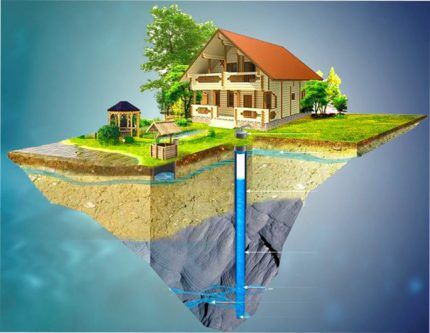
Sanitary standards and regulations
The sanitary standards required for the location of water-bearing wells are described in the documents SanPiN No. 2.1.4.110-02. Of course, first of all, this document concerns large water intakes that provide water to populated areas or individual enterprises and areas.
However, when installing a private well on your own property, it is recommended to adhere to sanitary standards.
In accordance with SanPiN standards, the minimum distance from the source of water intake to residential buildings is 30 m for protected groundwater, and 50 m for unprotected groundwater. It is clear that in the conditions of private construction it is impossible to comply with these standards.
Therefore, you should pay attention to the following rules:
- Directly near the well, on an area of at least 4x4 m in size, there should be no residential or commercial buildings.
- Industrial enterprises, large highways, landfills, cattle burial grounds, and cemeteries should not be located within a radius of at least 300 m.
- There should be no garden crops within a radius of at least 20 m that are irrigated using chemical fertilizers.
- The well should be as far as possible from cesspools, sewer septic tanks, compost heaps and similar objects. This applies not only to sources of possible pollution located on your site, but also to neighbors.
It is almost impossible to ensure full compliance with even these standards, therefore, if water from a well will be used not only for irrigation, but also for drinking needs, care must be taken to purify it. Drilling a deeper artesian-type well may also be a solution in this situation.

Selecting a point for drilling a water source
When choosing a place for well drilling The presence of aquifers is critical. Many factors will depend on the depth of their occurrence: the footage of the excavation, the drilling method, the need for cementing and installing filters, etc.
Let's take a closer look at what types of groundwater can serve as a water source for household needs and how to determine their depth.
Let's look at four types of groundwater that can become a source of water supply in your area:
- Verkhovodka - the upper aquifer layer, lying at a depth of 3-4 m. It is filled with melt and rainwater, therefore it is characterized by a high degree of pollution.It is prohibited to use such water for drinking and watering domestic animals; this water can be used for watering plants. During periods of drought and winter, the perched water may simply disappear, so drilling a well to them is never carried out.
- Groundwater at a depth of no more than 10 m. Such an aquifer is formed due to the fact that below it there are hydraulic-resistant soils that prevent water from seeping down. Groundwater does not dry out even during a drought. The quality of such waters is quite high; in most cases, if there are filtration systems and compliance with sanitary standards, they can be used for drinking.
- Interlayer free-flow waters. They lie at a depth of 10 to 110 m between two impermeable layers. The layers may have different structures and water permeability, for example, there may be sandy loam on top and loam below. Water quality is usually high, depending on the specific characteristics of the site. Wells that penetrate interstratal waters are most often found on private farms.
- Artesian waters. They are located at a depth below 40-110 m. Despite the fact that the water from an artesian well is clean and suitable for drinking, not every owner of the site decides to drill such a well. To open an aquifer, you need to go through a considerable thickness of rock, and this is a very labor-intensive process.
In addition, the device will require a package of permits. The fact is that in order to install an artesian well, it is necessary to coordinate with the administration of the locality and comply with current legislation, including the law “On Subsoil”.
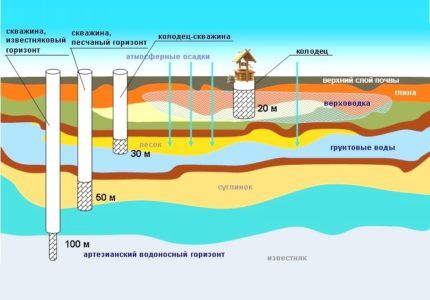
Visual methods for searching for groundwater
All methods used by specialists to determine the depth of the aquifer are based on accumulated experience and centuries-old observations, as well as on the properties of groundwater and their impact on the environment.
The best option is when the methods described below are used comprehensively, because Despite the high reliability, none of the methods provides a 100% guarantee.
Method #1 - vegetation on the site
Studying the vegetation of natural origin will help determine the level of perched water in your area. Pay attention to those plants that remain green and lush even in the driest period.
Approximate value of groundwater depth by plant type:
- cattail and reed, sedge - 1-3 m;
- black poplar - 1-3 m;
- wormwood - 3-6 m;
- alfalfa - 10-15 m.
The shallow location of the aquifer is indicated by trees such as cedar, willow, alder, and birch. But the presence of a pine tree on the site, on the contrary, indicates that the groundwater lies quite deep. If a well is drilled for economic purposes, then an area with similar vegetation is quite suitable.
Please note that annual plants are not indicators of the depth of the aquifer, because they have a short root system and receive the necessary moisture from natural precipitation, dew or perched water.
Method #2 - terrain in the area of the site
In most cases, the aquifer follows the surface topography of the area.That is why it is best to choose a low-lying area for drilling, because there the water will be closest to the surface. Also, the presence of an aquifer is indicated by longitudinal differences in the area, but it is quite difficult to notice them with an inexperienced eye.
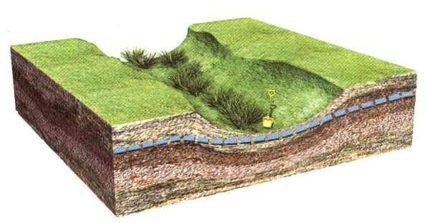
Despite the fact that lowlands are preferable for drilling, it is impossible to drill a well in wetlands, due to the fact that if the mine shaft depressurizes, very low quality water will flow into the well from the surface, constantly flooding the pit.
Also choosing a location water wells depends on the characteristics of the soil: it is advisable to drill in the place where the soil is best suited for development. In this case, sands, loams and sandy loams are much more preferable than rocks.
Method #3 - influence of nearby bodies of water
If there is a natural body of water (lake or river) within a radius of 300-500 m from your site, then with a high degree of probability the aquifer will be located at any point on the site. In this case, the rule applies: the closer to a natural reservoir, the higher and more abundant the aquifer will be.
When considering the distance of a site from a natural body of water, do not forget to take into account such factors as the discharge of sewage or industrial waste into it. In this case, the presence of a lake or river nearby will be more likely a negative phenomenon than a positive one.
This is especially true for sandy soils, which have high filtration rates, and if mechanical pollution is on the way to your site, it will most likely be filtered out.But harmful chemical compounds will probably get into the groundwater, and from there into the well site.
Clay rocks have low filtration characteristics, so the distance between the source of pollution and the water intake can be somewhat reduced. It is possible to construct a well on a layer of sand lying between clay soils.
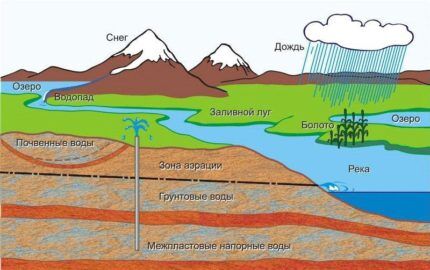
Method #4 - folk signs and observations
There are folk signs that our ancestors used during search for groundwater. Such signs include the abundance of morning dew in a certain area, as well as the accumulation of evening foggy haze. Such phenomena most likely indicate that groundwater is located close to the surface of the earth.
You can also make a prediction about the depth of water by studying the behavior of domestic animals in hot weather. Dogs do not like to lie where the aquifer comes close to the surface of the earth, but cats, on the contrary, choose such places to spend their time.
The shallow depth of water attracts insects; they swarm over such a place during and after sunset. But rodents and ants stay away from such places, preferring drier soils.
Of course, you shouldn’t completely rely on folk signs, but it wouldn’t hurt to take them into account in conjunction with other signs. Using folk clues, you can determine the location for the construction of an Abyssinian well.
Empirical ways to find groundwater
These methods include various methods that have proven themselves in the search for groundwater in areas of various types. To implement these methods, special equipment, measurements and analysis of the information received are required.
Despite their high accuracy, these methods also do not provide a 100% guarantee, however, in combination with visual signs, they can be considered reliable with complete confidence.
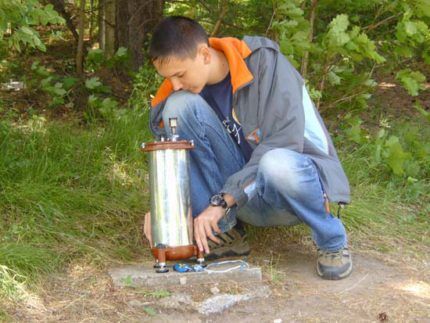
Method #1 - using a clay pot
An ancient method that our ancestors used to find underground water. The principle of operation of this method is as follows: a dry clay pot is taken and placed for a day in the expected location of the aquifer.
If after a day the inside of the pot fogged up and its walls became wet, then it was concluded that the water was close to the surface of the earth.
This method can be used in dry, warm weather. To obtain more accurate results, it is recommended to use several clay pots, comparing their condition after a day, which pot is the most wet inside, in that place and the depth of the aquifer is less.
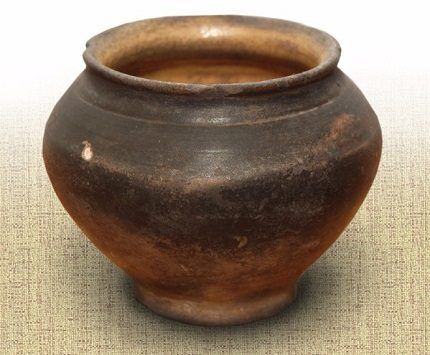
Method #2 - using silica gel
Silica gel is a synthetic polymer substance that can absorb moisture from the environment.Before use, the substance must be thoroughly dried if it has been stored open. Silica gel is placed in a bag made of natural fabric and weighed; it is enough to take 100-300 g.
After this, the bag (or several bags) is buried at the points where the water-bearing well is supposed to be located at a depth of 0.8-1 m. After a day, the bags of silica gel are dug up and weighed.
In the place of greatest saturation with water, silica gel will absorb the greatest amount of moisture, which will affect its weight; it will increase by 1.5-3 times. The greater the increase in weight, the closer to the surface the aquifer lies.
Instead of silica gel, you can use any desiccant, for example, pre-crushed and dried clay brick.
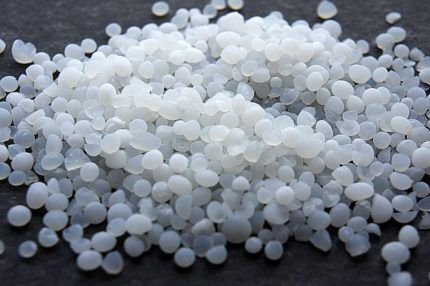
Method #3 - electrical probing
To search for groundwater using this method, special equipment is required. In this case, it is impossible to do the search yourself; you will have to turn to professionals, however, the reliability of this method is very high.
The operating principle is as follows:
- soil resistivity measurements are taken at different points on the site;
- As a result of research, the aquifer is determined.
Groundwater is recorded in the place where instrument readings range from 50 to 200 Ohms. The method is not suitable if there are underground communications and metal structures on the site, because devices will give unreliable results.
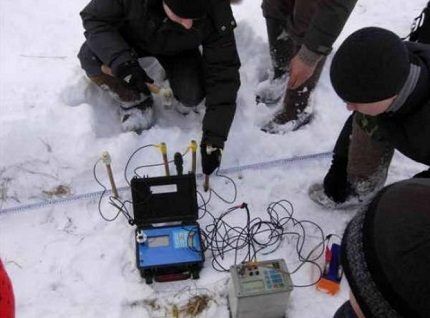
Method #4 - frame search
The dowsing method is the most famous and at the same time controversial method. Some experts consider it effective and scientifically based, while others call it quackery. However, there are many documented cases where groundwater was found using dowsing.
To implement this method, it is necessary to prepare a frame of aluminum wire 50 cm long. The ends of the wire are bent at right angles. The frame is inserted into the branches of viburnum, hazel or elderberry.
Next, perform the following steps:
- Using a compass, we determine the cardinal directions and mark them on the site.
- We slowly cross the area from north to south, and then from east to west, holding the dowsing frame in our hands.
- At the location of the aquifer, the frames will begin to move.
- Moving in different directions and following the movement of the frame, we determine the direction of the aquifer.
The use of a frame is based on the action of magnetic fields, so this method is not suitable if the soil of the site contains a large amount of iron ore or there are radar towers nearby that distort the data of the frame biolocator.

All the methods discussed above are widely used to search for an aquifer and the location of determination drilling a shallow well or an Abyssinian well. However, as already mentioned, none of them gives a guarantee that when you start drilling, you will encounter groundwater at the expected depth.
Is there a way to determine the groundwater horizon in a particular place? Is it possible to accurately determine the depth of an aquifer? Yes, if you use the exploratory drilling method.
Reliable prospecting method by exploratory drilling
The most reliable way to avoid annoying miscalculations is to search for official information about the hydrogeological situation of the site. You can obtain data from a local drilling organization or from a meteorological service that has all the information about the geological and climatic specifics of the region.
To carry out independent exploration, you can use a manual method that does not require financial costs. Before starting drilling operations, it is necessary to prepare the required equipment: a hand drill, a shovel, and also take care of the storage location for the soil raised to the surface.
This method is suitable for soft soils that can be drilled with a hand drill. For denser rocks, you will have to call drillers and use more serious equipment.
Advantages of exploration drilling:
- 100% result of searching and determining the depth of groundwater;
- the ability to assess groundwater;
- the ability to accurately calculate the cost of drilling.
An exploration well is usually installed in the location chosen for water intake. Those. No one will conduct exploration specifically for a private owner - it is expensive, because you will have to pay for each drilled meter at the usual rate, and it is pointless.
If there is no water in a well at a depth acceptable for operation, it is classified as an exploration well and is simply backfilled with soil extracted during drilling.No one else will drill anything in this area - it’s useless. If the well has discovered an aquifer, simply equip the source and construct a water supply system on the basis of the water intake.
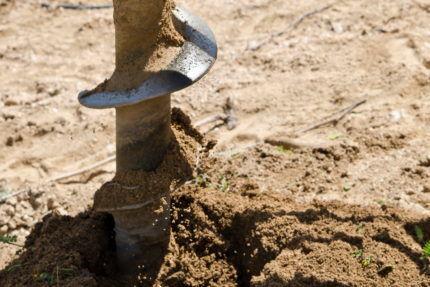
Unsuitable places for a well
The main condition for well installation on site is the presence of an aquifer. However, even if this is observed, in some cases drilling a well is impossible.
Signs of unsuitability for a well location are:
- the presence of sources of groundwater pollution in the immediate vicinity;
- a place near sewerage systems and wastewater;
- location near environmentally unfavorable natural reservoirs;
- close proximity of power lines and laying of underground communications along the site;
- trees with a branched root system.
Particular attention should be paid to compliance with sanitary standards; if they are violated, drilling a well cannot be done. Also, you should not place a well next to the fence of a neighbor’s property, because you cannot predict what a neighbor will build on his land in close proximity to your water source.
Well in the basement of a house
Many homeowners consider placing a well in the basement of their home an ideal option.
Indeed, if the aquifer runs right in the area where the house is located or will be built, then this option will have many advantages:
- significant simplification and reduction in cost of the process of installing water supply from a well;
- the shortest water supply route;
- no need for insulation or caisson construction.
If desired arrange a water intake within the house, it is necessary to drill a well at the construction site even before the construction of the foundation. It is optimal to reflect in the house design the presence of a water-bearing well in the basement.
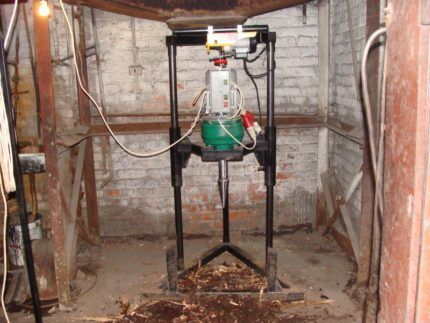
Disadvantages of locating a water-bearing well in the basement:
- sufficient space is required;
- difficulties with installing pumping equipment due to inaccessibility of the well;
- problems in the washing process with sewage removal;
- the possibility of soil erosion around the water source and the threat of subsidence of the foundation of the house.
At least 1 month must pass between the completion of drilling and the start of foundation construction. This period is necessary to identify and eliminate all problems associated with the operation of the well.
Please note that there should be enough space around the well for its maintenance or repair.The minimum size of the maintenance area is 3x4 meters.
Optimal time for drilling
Having decided the question of where it is best to drill a water-bearing well, you need to decide when to drill. Experts believe that each season has its pros and cons for drilling operations. They unanimously agree on one thing: you can’t drill a well in the spring.
There are several reasons for this:
- the presence of a flood increases the groundwater level;
- it is impossible to reliably determine the location and depth of the aquifer;
- spring thaw will make it difficult for drilling equipment to travel.
In most regions of Russia, drilling wells is impossible from March to May, in the northern regions from April to mid-June. In arid regions, it is also not recommended to carry out drilling work in the spring, even in the absence of a flood; in this case, groundwater is still unstable, its level is noticeably increased.
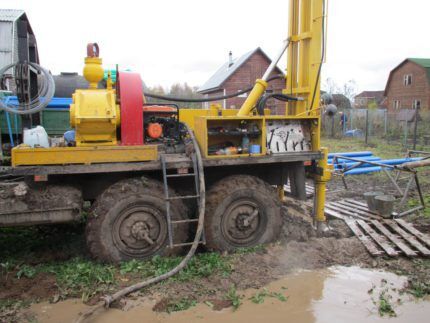
Summer-autumn period
The best time to install a well is July-September. At this time, the water level is at its minimum, which means that the optimal horizon for the future well can be accurately determined.
Also, the advantages of carrying out drilling operations in the summer-autumn period include:
- dryness and stability of the soil;
- possibility of access of special equipment;
- comfortable temperature for drilling operations.
Many land owners prefer to begin work on constructing wells in the fall after harvesting, so that special equipment does not damage the plantings, and when flushing the well, crops are not flooded with contaminants.
When planning to install a well for the period August-early September, keep in mind that at this time the drilling companies are busy, so it is necessary to agree on a date in advance.
Drilling in winter
Winter is the ideal time to drill artesian and sand wells to groundwater. In this case, the risk of error in incorrect identification of the aquifer is minimized, because the perched water does not interfere with determining the groundwater level.
Modern technology easily copes with frozen soil, while causing minimal damage to the topography of your site.
Flushing the well is a must; it is not done just for the sake of pumping out muddy water. The soil collapsed during drilling can clog the pump and instantly disable it. That’s why they choose inexpensive ones for pumping vibration units of the Rucheek type, which you won’t be sorry to part with right away.
An important factor: in winter, the number of clients of drilling companies decreases, which means the cost of drilling work decreases.
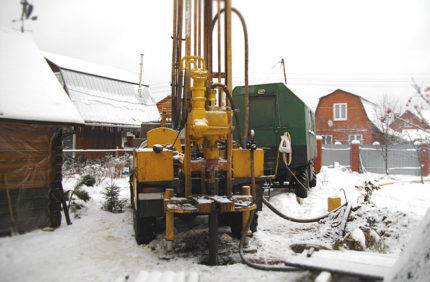
Conclusions and useful video on the topic
Video #1. Selecting a location for drilling a water-bearing well on the site:
Video #2. Practical application of the dowsing method when searching for water:
Video #3. Video about self-exploration using a primitive drilling method:
Choosing the right location for a well is an important event on which the further operation of the water supply system of your site and home depends..
It is imperative to take into account sanitary standards and the location of the foundation. It is advisable, if possible, to shorten the external water supply route if automation of the system is planned.
Those wishing to share their own experience in determining the optimal location for installing a water intake in a suburban area are invited to leave comments. If there are any controversial issues in the information provided, ask questions. Please comment in the block below.




The material presented states that the best time to drill a well is from July to September. But in the section “Drilling in Winter”, arguments are given in favor of winter drilling as ideal. I'm a little confused, what time of year is it best to order this work? I am leaning more towards winter, so that the equipment does not leave large marks on the site.
Maybe I’ll tell someone a secret, but drilling in winter is profitable, not for drillers, but for clients. In winter there are not many orders, so good discounts are offered on services. As for seasonal conditions, there are also some nuances here. For example, it is better to drill a sand well during a dry period, since in this case it will be clear whether there is water there.
If you are afraid for the safety of the site, then it is best to drill not only in winter, but also during periods of drought. In this case, there will be minimal traces from heavy equipment.
In general, late summer and early autumn is the peak period for drilling operations. The groundwater level is at a minimum, the earth has been compacted, leaving only dry soil on the site.
I drilled a well in August. The experts also affirmatively said that there should be no extraneous influencing factors to determine the depth. True, they themselves could not say exactly at what level the aquifer would open. I’m wondering if the grandfathers used to accurately determine whether there was water or not, and whether it was even worth digging a well in this particular place, but now with advanced technologies they still turn to proven methods. As a result, they drilled to 35 meters. I have already used it for at least 2 years, no problems with water even in dry weather.
Can a well 30 meters deep affect a nearby country house (cause subsidence of the foundation)? The well is located at a distance of 1.5-2 m from the foundation of the country house.
In theory, ground failures, and with it the settlement of the foundation, can be caused by incorrect and careless actions of would-be drillers. If the well has already been drilled, then there should be no subsidence.
And there are people who generally make wells directly inside the perimeter of the house. It’s true that it is not clear how they are going to clean and maintain this well.
In this case, you don’t have to worry about the safety of the foundation. The diameter of the well is small enough to damage the foundation. And you will be pumping water for domestic needs, and not on an industrial scale. So a cavity without water of critical dimensions does not form under the foundation.
I was also puzzled by this problem. I have drilled a 42m well. Filter up to 30 m. I planned to build a house two meters from it. But when they pumped the well after drilling, I filled the container with this water. The water was cloudy, which is generally how it should be. I filled a 2 cc container with this water. When the turbidity settled at the bottom, according to my calculations, there was about five centimeters of sediment, if not more. They may be wrong. Maybe less. After all, this is all a washed-out breed. It is clear that she should then go clean. But all the same, over the years of operation it will be washed out. Voids are formed. And ground subsidence may occur. In general, I was upset that I drilled a well in this place. Please tell me how wrong I am or not in my fears.
Hello! Is it possible to make a well in the technical room of the house? or should we not do this at all?